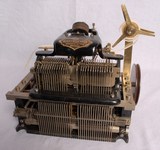Home: Relays
Please Note: Not all of the objects on this website are on display at the museum.

Larger image |
POST OFFICE GULSTAD 304 RELAY, 1900's The Gulstad Relay was invented by K.Gulstad of Copenhagen in 1898 A0238 |

Larger image |
POST OFICE RELAY 'B' No 14802, 1920's Relay used in telegraphy acting as a form of amplifier for the signal, sensitive coils moved the contacts which controlled equipment that could be powered locally. A0278 |

Larger image |
POST OFFICE RELAY 'B' No 5462, 1920's Odd version marked as 'B' but more like a 'D' relay, for information on Telegraphy relays see item A0252. it has a single throw contact is non polarised (no magnet) has only one coil, with no other markings. A0277 |

Larger image |
POST OFFICE RELAY TYPE G, 1920's Used in telegraphy systems to amplify power and and enable equipment to be powered locally. Post Office Relay 'G' on a pluggable base. A0253 |

Larger image |
POST OFFICE RELAY TYPE B No 9534, 1920's Relay used in telegraphy acting as a form of amplifier for the signal, sensitive coils moved the contacts which controlled equipment that could be powered locally. Post Office Standard Relay 'B' A0252 |

Larger image |
POST OFFICE RELAY TYPE B No 7938, 1920's Used in Telegraphy to amplify the power lost on long cables, by activating a sensitive coil which moves contacts that operate equipment powered locally. Post Office Standard Relay 'B' taller version. A0254 |

Larger image |
SIEMENS GIANT TELEGRAPH RELAY, 1930's Hermetically sealed (watertight) Large Telegraphy Relay in Brass container. Be the first to write a comment about this objectA0774 |

Larger image |
GPO REVERSING RELAY, 1950's Relay used for reversing polarity of lines, made from an old Morse sounder. A0081 |

Larger image |
BRITISH RAIL RELAY, 1957 Originally sold at the BT museum auction . A0082 |
Further Reading (external sites):
Back to top









